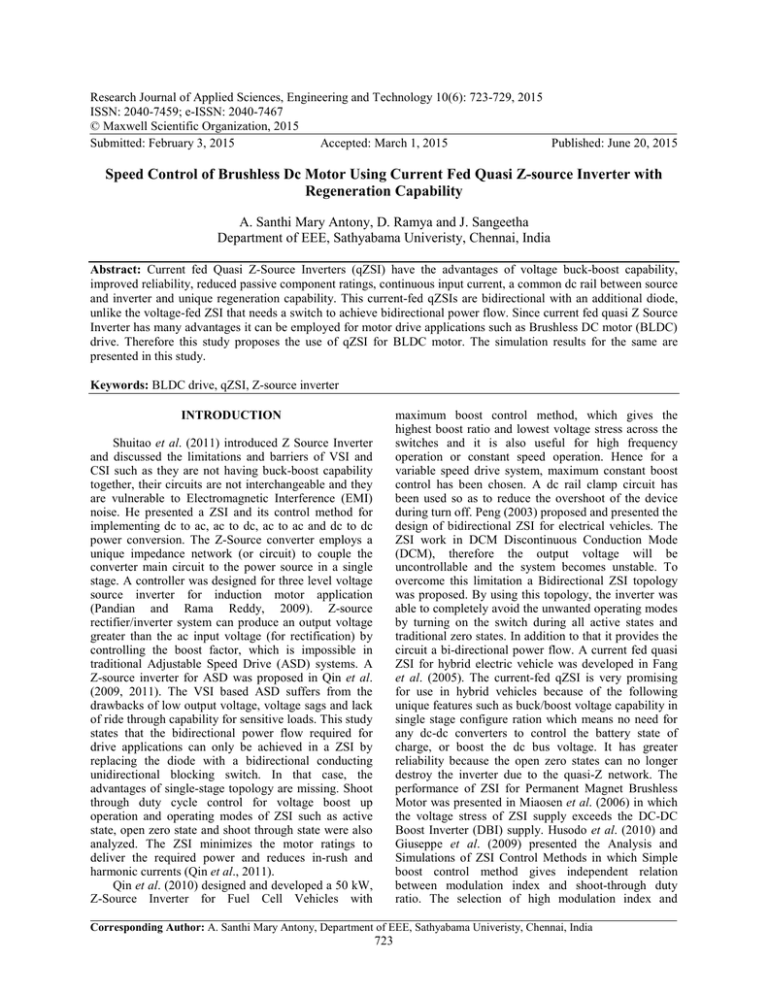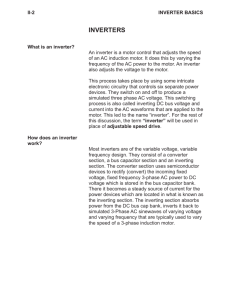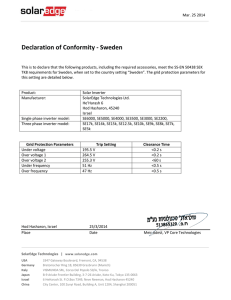Research Journal of Applied Sciences, Engineering and Technology 10(6): 723-729,... ISSN: 2040-7459; e-ISSN: 2040-7467
advertisement

Research Journal of Applied Sciences, Engineering and Technology 10(6): 723-729, 2015 ISSN: 2040-7459; e-ISSN: 2040-7467 © Maxwell Scientific Organization, 2015 Submitted: February 3, 2015 Accepted: March 1, 2015 Published: June 20, 2015 Speed Control of Brushless Dc Motor Using Current Fed Quasi Z-source Inverter with Regeneration Capability A. Santhi Mary Antony, D. Ramya and J. Sangeetha Department of EEE, Sathyabama Univeristy, Chennai, India Abstract: Current fed Quasi Z-Source Inverters (qZSI) have the advantages of voltage buck-boost capability, improved reliability, reduced passive component ratings, continuous input current, a common dc rail between source and inverter and unique regeneration capability. This current-fed qZSIs are bidirectional with an additional diode, unlike the voltage-fed ZSI that needs a switch to achieve bidirectional power flow. Since current fed quasi Z Source Inverter has many advantages it can be employed for motor drive applications such as Brushless DC motor (BLDC) drive. Therefore this study proposes the use of qZSI for BLDC motor. The simulation results for the same are presented in this study. Keywords: BLDC drive, qZSI, Z-source inverter maximum boost control method, which gives the highest boost ratio and lowest voltage stress across the switches and it is also useful for high frequency operation or constant speed operation. Hence for a variable speed drive system, maximum constant boost control has been chosen. A dc rail clamp circuit has been used so as to reduce the overshoot of the device during turn off. Peng (2003) proposed and presented the design of bidirectional ZSI for electrical vehicles. The ZSI work in DCM Discontinuous Conduction Mode (DCM), therefore the output voltage will be uncontrollable and the system becomes unstable. To overcome this limitation a Bidirectional ZSI topology was proposed. By using this topology, the inverter was able to completely avoid the unwanted operating modes by turning on the switch during all active states and traditional zero states. In addition to that it provides the circuit a bi-directional power flow. A current fed quasi ZSI for hybrid electric vehicle was developed in Fang et al. (2005). The current-fed qZSI is very promising for use in hybrid vehicles because of the following unique features such as buck/boost voltage capability in single stage configure ration which means no need for any dc-dc converters to control the battery state of charge, or boost the dc bus voltage. It has greater reliability because the open zero states can no longer destroy the inverter due to the quasi-Z network. The performance of ZSI for Permanent Magnet Brushless Motor was presented in Miaosen et al. (2006) in which the voltage stress of ZSI supply exceeds the DC-DC Boost Inverter (DBI) supply. Husodo et al. (2010) and Giuseppe et al. (2009) presented the Analysis and Simulations of ZSI Control Methods in which Simple boost control method gives independent relation between modulation index and shoot-through duty ratio. The selection of high modulation index and INTRODUCTION Shuitao et al. (2011) introduced Z Source Inverter and discussed the limitations and barriers of VSI and CSI such as they are not having buck-boost capability together, their circuits are not interchangeable and they are vulnerable to Electromagnetic Interference (EMI) noise. He presented a ZSI and its control method for implementing dc to ac, ac to dc, ac to ac and dc to dc power conversion. The Z-Source converter employs a unique impedance network (or circuit) to couple the converter main circuit to the power source in a single stage. A controller was designed for three level voltage source inverter for induction motor application (Pandian and Rama Reddy, 2009). Z-source rectifier/inverter system can produce an output voltage greater than the ac input voltage (for rectification) by controlling the boost factor, which is impossible in traditional Adjustable Speed Drive (ASD) systems. A Z-source inverter for ASD was proposed in Qin et al. (2009, 2011). The VSI based ASD suffers from the drawbacks of low output voltage, voltage sags and lack of ride through capability for sensitive loads. This study states that the bidirectional power flow required for drive applications can only be achieved in a ZSI by replacing the diode with a bidirectional conducting unidirectional blocking switch. In that case, the advantages of single-stage topology are missing. Shoot through duty cycle control for voltage boost up operation and operating modes of ZSI such as active state, open zero state and shoot through state were also analyzed. The ZSI minimizes the motor ratings to deliver the required power and reduces in-rush and harmonic currents (Qin et al., 2011). Qin et al. (2010) designed and developed a 50 kW, Z-Source Inverter for Fuel Cell Vehicles with Corresponding Author: A. Santhi Mary Antony, Department of EEE, Sathyabama Univeristy, Chennai, India 723 Res. J. App. Sci. Eng. Technol., 10(6): 723-729, 2015 shoot-through duty ratio can reduce the inverter’s dc link voltage overshoot and increasing power delivery capacity of the inverter which is termed as Simple Boost control. Selection of constant value of shoot through duty ratio in all modulation period results in reduced passive component rating and selecting a lower value of shoot through duty ratio reduces the voltage stress which is termed as maximum constant boost control. Husodo et al. (2010) presented a Current-Fed QZSI with Voltage Buck-Boost and regeneration Capability. The Current fed quasi Z-Source Inverter replaces the two stages of bidirectional DC-DC converter and conventional pulse width modulation inverter to control the power of the motor and the state of charge of the battery in hybrid vehicles in single stage configure ration. Qin et al. (2011) presented the discontinuous operation modes of current fed quasi Z source inverter. The Current fed qZSI has lower current stress on inductor compared to current-fed ZSI. The analysis and control methods proposed in Fang et al. (2005) are based on the assumptions that the capacitor voltage is almost constant and equal to the input voltage. These assumptions become invalid when the capacitor is very small or the load power factor is low in some applications that the volume is a very crucial factor. The capacitor voltage has high ripple or even becomes discontinuous. In these cases, the circuit has two new operation modes except for the normal three modes, which is called discontinuous operation modes. This study analyzed the characteristics of the discontinuous operation modes and derived the critical conditions for these new modes under different control strategies. pulses for inverter are generated based on the signals obtained from Hall sensors of a BLDC motor. The motor specifications are as follows: Rated Voltage -160 V Power -373 W Resistance (Per phase) -0.7 Ω Inductance (Phase-Phase) -2.72 mH Speed constant 18.62 rpm/volt Torque constant -0.049 nm/A Number of poles -4 Rated speed -4000 rpm Rated current -17.35 A Moment of Inertia -0.0002 g-cm2 Governing equations of current FED QZSI: Direct voltages and currents are involved in the Z network. The impedance link delivers a current that is assumed to be constant in each mode. is the current drawn from the Z-link by the load. is the open zero duty ratio. Current fed to the inverter bridge = 20A = Z link current. Input current of the current fed QZSI: = + (2 ∗ ) = ( (1) ) ∗ = ∗ (2) Relation between output peak ac current and Z link current: MATERIALS AND METHODS √ Circuit description: The proposed circuit is shown in Fig. 1. Current fed qZSI feeds the inverter. The inverter supplies stator winding of a BLDC machine. The PWM Peak ac current = ∗ ∗ (3) Rms value of ac current Io(rms) = i/√2 (4) Fig. 1: Quasi-ZSI fed BLDC motor drive 724 Res. J. App. Sci. Eng. Technol., 10(6): 723-729, 2015 √ Inverter gain G = i /( ∗ Iin) Inverter gain = ∗ ∗ " = ∗ : ∗ ;$∅ ∗ ( ) (5) Design spécifications: (6) DC input voltage: 48 V Source inductor: 2 mH Switching frequency -20 kHz; Tsw = 1/fsw = 50 µsec Peak to Peak ac output voltage +30 to -30 V Output power of the converter = 600 W Voltage rating of the converter = 30 V Current rating of converter = 20 A AC output frequency = 50 Hz Inverter gain G = B*M = 1.9 = 2 (approximately) Let = 1/(1 − 2) 3 = "/# The current stress of the switch is equal to the current at pn is: $ = Ipn = (7) ∗ ∗ Iin = B ∗ Iin In current fed qZSI to have continuous mode of operation, Vc should be 48 V: L1 = L2= = > Capacitor voltage increases in open zero state. So the peak to peak value of voltage ripple is: ∆Vc = ,-∗./0 1 = (I + Il) ∗ Top (8) C1 = C2 = K = ∆67 (CLMN∗A@B∗?@) (O.O∗67) = 2.5 mH (11) assuming a 3% (12) SIMULATION RESULTS ) = ("/Iin) − ((1 − Dop)/(1 − 2Dop) ∗ (Iin) ∗ (Top/(2 ∗ C)) ?@∗A@B∗67 (CD?E7FG GHIJ 7EGGJDF) ripple in capacitor voltage =100 uF where, 5 = ∗ 5$. To have continuous mode of operation: Vc ((min)= # − ( (10) The Simulation Circuit shown in Fig. 2 is for six pulse operation using position sensor feedback. As BLDC motors are electronically commutated rotor position information is needed for proper commutation. Commutation refers to the sequence of energizing stator coils for proper rotation of motor. This position information is provided by three Hall Effect sensors. The switching pulses are shown in Fig. 3. The input DC (9) Assume the load impedance is Z. From the power balance, the input power can be calculated by output current as: Fig. 2: Simulation circuit for six pulse operation 725 Res. J. App. Sci. Eng. Technol., 10(6): 723-729, 2015 Fig. 3: Sequence of gating pulses Fig. 4: DC input voltage Fig. 5: No load speed 726 Res. J. App. Sci. Eng. Technol., 10(6): 723-729, 2015 Fig. 6: Hall sensor output Fig. 7: Stator line currents during no load and load conditions Table 1: Simulation specifications Parameter name Simulation parameter DC input voltage DC input Source inductor Ls Z link inductors L1 and L2 Z link capacitors C1 and C2 Z link voltage Vz link Stator line currents Ia, Ib and Ic Stator line voltages Vab, Vbc and Vca (RMS) voltage to the current fed qZSI is 48 V to produce an output voltage of 30 V (line-line) rms using PWM duty cycle control. This dc input voltage is shown in Fig. 4. The no load speed is shown in Fig. 5. Rotor position information needed for commutation purpose is provided by three Hall Effect sensors. A Hall Effect sensor is a type of position sensor that provides three pulses depending on the rotor shaft position. The three logic signal output pulses A, B and C are spaced 1200 apart. The Hall Effect sensor output is shown in Fig. 6 and Table 1. Value 48 V 2 mH 2 and 2 mH 100 and 100 µH 48 V 20 A 30 V During load conditions the motor draws more current with increase in torque and reduce in speed as voltage drops to drive the load. As BLDC motors are 727 Res. J. App. Sci. Eng. Technol., 10(6): 723-729, 2015 Fig. 8: Speed waveforms Fig. 9: Load current waveform Fig. 10: Load torque waveform 728 Res. J. App. Sci. Eng. Technol., 10(6): 723-729, 2015 generally star connected the line current and phase currents are of same value of square wave pattern. Here load is connected from 0.5 to 1.5 sec for a total duration of 2 sec. The change in stator line currents during no load and load conditions are shown in Fig. 7. The speed variation during load change is shown in Fig. 8. As BLDC motors mimic the characteristics of DC shunt motor the torque is directly proportional to stator armature current. The motor is driving a load which draws a current of nearly 13A from motor. Here load is connected from 0.5 to 1.5 sec. The increased load current and load torque is shown in Fig. 9 and 10 respectively. Miaosen, S., A. Joseph, H. Yi, F.Z. Peng and Q. Zhaoming, 2006. Design and development of a 50kW Z-source inverter for fuel cell vehicles. Proceeding of the CES/IEEE 5th International Power Electronics and Motion Control Conference, pp: 1-5. Pandian, G. and S. Rama Reddy, 2009. Fuzzy control of multilevel inverter fed direct torque control scheme for induction motor drive. Int. J. Intell. Electron. Syst., 3(1). Peng, F.Z., 2003. Z-source inverter. IEEE T. Ind. Appl., 39(2): 504-510. Qin, L., F.Z. Peng and Y. Shuitao, 2011. Discontinuous operation modes of current-fed Quasi-Z-Source inverter. Proceeding of the 26th Annual IEEE Applied Power Electronics Conference and Exposition (APEC, 2011), pp: 437-441. Qin, L., Y. Shuitao, Z.P. Fang and R. Inoshita, 2009. Application of current-fed Quasi-Z-Source Inverter for traction drive of hybrid electric vehicles. Proceeding of the IEEE Vehicle Power and Propulsion Conference, pp: 754-760. Qin, L., F.Z. Peng, H. Liangzong and Y. Shuitao, 2010. Power loss analysis of current-fed quasi-Z-source inverter. Proceeding of the IEEE Energy Conversion Congress and Exposition (ECCE, 2010), pp: 2883-2887. Shuitao, Y., F.Z. Peng, L. Qin, R. Inoshita and Q. Zhaoming, 2011. Current-fed quasi-Z-source inverter with voltage buck-boost and regeneration capability. IEEE T. Ind. Appl., 47: 882-892. CONCLUSION A current fed qZSI having for a BLDC motor was designed. From the simulation results it is observed that due to the presence of energy storage elements in the Z link it is possible to get voltage buck/boost capability and inversion in single stage configuration. From the simulation results it is also observed that the qZSI supports BLDC for variable speed/torque operation. But the ripple content in torque is high; therefore the research can be further focused on reducing the torque ripple. REFERENCES Fang, Z.P., J. Alan, W. Jin, S. Miaosen, C. Lihua, P. Zhiguo, O.R. Eduardo and H. Yi, 2005. Z-source Inverter for motor drives. IEEE T. Power Electr., 20(4). 729








